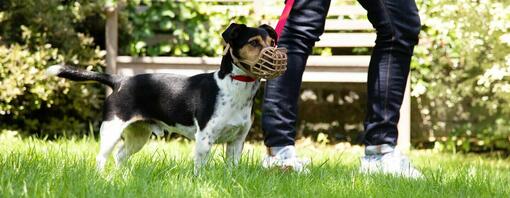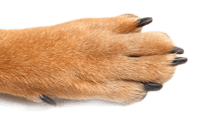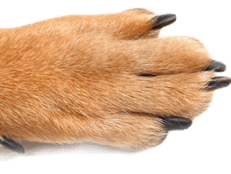What is Reactive Dog Behaviour? Signs, Causes, and How to Help

When we talk about "reactivity" in dogs, we're describing a tendency to overreact to certain stimuli in their environment. While it can be difficult for owners and dogs alike, it is important to understand that reactivity isn't ‘bad’ or ‘aggressive’ behaviour. Instead, it's often rooted in underlying emotions like fear, anxiety, or frustration. Let’s delve deeper into what reactivity in dogs looks like and how we can manage these complex emotional responses to create a calmer, more confident canine companion.
Understanding dog reactivity
We all think we know what a reactive dog looks like. They’re the ones who lunge at the end of the lead, barking furiously at other dogs or people, and looking pretty scary while causing their owner to have to hang on for dear life to keep control of them, While this is often true, canine reactivity is probably one of the most common problems seen by behaviourists, and the most misunderstood of canine issues.
Just saying a dog is ‘reactive’ however isn’t helpful because it doesn’t describe the behaviour accurately and more importantly, it doesn’t describe the emotion behind the behaviour. It’s easy to think of reactive dogs as being aggressive – however this is rarely the truth.
Behaviour is a nothing more than a symptom of how a dog is feeling – and so-called ‘reactive’ dogs, can be feeling a wide range of emotions.
You can’t change any dog’s behaviour without understanding and changing the emotion that drives that behaviour – so let’s look at some of the possible feelings that can lead a dog to behaving reactively, and so get better understanding of what causes a dog to be reactive and what you can do to help them.
Key Signs of a Reactive Dog
The following are some of the behaviours you can see when a dog is behaving reactively. It is however important to remember that every dog is an individual, and so they may not show all or and of these.
Reactivity is generally triggered by other dogs, unfamiliar people, novel stimuli, and/or sometimes unexpected movement.
Excessive Barking
One of the signs of reactivity in dogs is often excessive barking while hyper-focussed on the trigger. This isn't just a simple 'woof' to alert you; it's typically a high-pitched, frantic, and ongoing barking while the trigger is present. Other vocalisations such as growling may also be present.
Lunging at Other Dogs or People
Another sign of reactivity in dogs can be lunging. This is a sudden, forceful movement towards the trigger, and often goes together with vocalisation and other aggressive-looking body language such as piloerection. This is usually shown when the dog is on the lead - and can be difficult for an owner to deal with and potentially dangerous.
Hyper-focus
The dog seems almost transfixed by the trigger and their entire focus will be on it. They will be hard/impossible to distract and will refuse treats.
Causes of Dog Reactivity
Fear
The one thing all reactive dogs have in common is overarousal to common stimuli, and they become so preoccupied with whatever that trigger is that they become hard to control, hyper-focussed, almost impossible to distract, and difficult to remove from the situation. While we might think that the feeling behind this behaviour is aggression, in most cases, a reactive dog is a fearful dog.
This fearfulness could be genetic, it could be due to a lack of appropriate socialisation, it could be due to a previous bad experience, or it could even be a behaviour learned from other family dogs. Without careful management – and often professional guidance – a fearful dog can easily be pushed into becoming aggressive as a way to cope with certain situations.
Frustration
Sometimes apparent reactivity can have its origins in the very opposite of aggression. Over-friendliness and/or over-enthusiasm!
A dog can get so excited at the sight of other dogs and the desire to go and interact with them, that they will lunge and bark but because the lead prevents them from any canine interaction, that can easily turn to frustration and even to aggressive behaviours. This often is the result of a lack of socialisation or else poor socialisation, and can often be exacerbated as a dog struggles with changes that adolescence brings.
Good socialisation teaches dogs how to listen to their human in different situations, and to be calm around other dogs – and also that other dogs are not necessarily for playing with. Dogs who haven’t been socialised - or else have been in poor puppy classes where the hour has been spent charging around with other dogs – haven’t learnt how to be relaxed and calm around other canines or unknown humans and other novelty.
Lack of outlets for natural/hardwired behaviour
Without appropriate exercise, an outlet for their hardwired behaviours, and suitable enrichment opportunities, a dog can get bored, frustrated and hyper-active (or depressed). This can easily lead to reactive behaviour – which then becomes a vicious circle, as usually their owner gives them less exercise and fewer activities (as they are such a nightmare to take out) and in turn the dog has more energy and is even more bored and frustrated.
Inappropriate training methods/equipment
Using equipment or methodology that causes pain or fear, increases arousal and stress, and so very often increases reactivity – and breaks down the dog/owner bond.
What to do if your dog is behaving reactively
Reactivity needs professional help and/or ongoing behaviour modification and training. However if your dog behaves reactively while you are out, identify the trigger and immediately create space between your dog and that trigger, prioritising the safety of everyone around you.
It’s really important to never punish your dog for reacting as this can impact them negatively and cause them to be more stressed and anxious next time.
Ideally however you want to avoid situations where you know your dog is likely to behave reactively. Every time a dog behaves in a certain way, the more ingrained that behaviour becomes.
Is it really reactivity?
Sometimes over-excitement, exuberance and misplaced canine enthusiasm can appear a lot like reactivity. There can be similar lunging, barking, leaping around – but often it is accompanied by a loosely wagging tail and friendly body language, and the dog can usually be fairly easily distracted.
When to seek professional help
If you have a reactive dog, whatever you think the reasons might be, the very best thing to do is talk to a canine behaviourist who can assess your dog and help you develop and implement a behaviour modification plan involving desensitisation and counter conditioning.
In the meantime, take a proactive management approach. Make sure your dog is getting an outlet for their hard-wired behaviour needs, that they are getting enough appropriate exercise, and enough social company. Avoid putting your dog in situations where you know they are likely to behave in a reactive way (behaviours that are practised, get better!), change your walking times and routes if that will make you less likely to encounter any triggers, and use a muzzle if you think your dog could cause anyone injury.
If your dog is showing signs of anxiety or fear look into ways of helping a frightened dog and seek professional advice if there’s no improvement.
FAQ
All breeds and individuals can become reactive – but the ones that most people seek treatment for are the ones that become difficult to handle. Dogs who are bred to be constantly alert and react to movement or external stimuli as part of their breed ‘job’ are often the ones whose reactivity behaviours are more extreme.
Any behaviour that is practised, gets better – so if your dog is reactive already, get help from a professional behaviourist so make sure it doesn’t get worse.
Take advice from a behaviourist as part of a behaviour modification plan. Sometimes giving your dog a break from feeling stressed, worried, or frustrated can help both them and you – but they still need plenty of enrichment and exercise.
Seeking help from a fully accredited behaviour professional isn’t something you should ever feel reluctant to do or be ashamed of. We expect our dogs to live increasingly complex lives as parts of our families and sometimes they need a bit of help. Visiting a behaviourist for behaviour problems should be exactly the same as visiting your vet for clinical problems.





